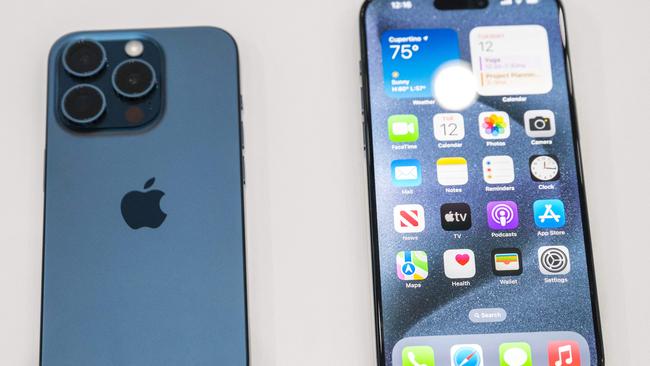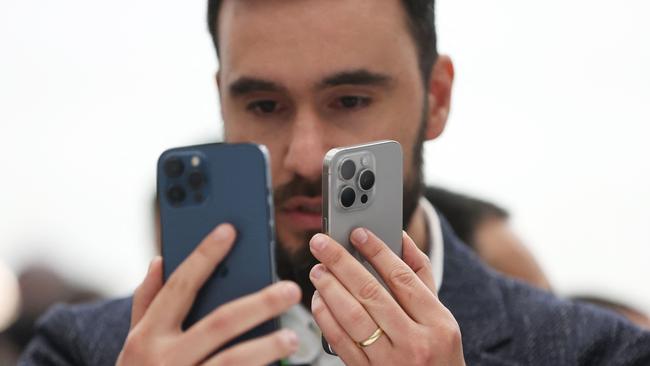What’s new in Apple’s pricier iPhones line-up
Apple’s shares fell after unveiling new iPhone 15s with mostly evolutionary features that it expects consumers will pay a bit more for, amid growing uncertainty in China.

Business
Don't miss out on the headlines from Business. Followed categories will be added to My News.
Apple is pushing further into its strategy of getting people to pay more for their iPhones.
The US tech giant’s latest iPhone 15 line-up, announced at a company event overnight, featured a number of mostly evolutionary advances for its Pro models. It is expecting consumers to pay a bit more for the most advanced features.
The iPhone 15 Pro Max will start at $US1199 for the 256-gigabyte model, up $US100 from last year’s iPhone 14 Pro.
Apple said it’s the same price as last year’s Pro Max model with the same storage, but it eliminated the lower-price 128-gigabyte model. The company’s regular iPhone 15 models will mostly offer incremental improvements regularly seen in such updates: better camera, improved battery and new software features.
For the higher price Pro models, Apple is offering a new titanium case to make the phones lighter. It will come with four titanium colours: black, blue, white and a natural metallic colour. The screen on the Pro pushes further out to the edges of the device.
The Pro models’ also do away with the mute switch found in every phone since the first model. In its place, Apple now offers a customisable button to quickly pull up the camera or certain apps.

The Pro models are powered with a chip, called the A17 Pro, built on the new 3-nanometer fabrication process from Taiwan Semiconductor Manufacturing.
The Pro camera system also gets a bump, especially in the larger Pro Max, with a camera able to zoom up to five times for taking pictures from a long distance. The Pro models also can capture 3-dimensional video that can be viewed later on the Apple Vision Pro, the company’s headset that won’t be available until early next year.
Apple shares closed lower with the decline in the stock likely due to investors hoping for price increases in the base model phones to grab more margin, said Brian Mulberry, client portfolio manager at Zacks Investment Management, an Apple shareholder.
“Apple is sensitive to the fact that the strength of the consumer is starting to wane,” said Mulberry. “It seems to be tactically right to be accessible, but also to stretch margins for higher-end phones.”
Apple is hoping these advancements are enough to keep sales up, even as the smartphone market cools. Global smartphone shipments are expected to decline 6 per cent annually to 1.15 billion devices by the end of 2023, the lowest smartphone shipment figure in a decade, according to Counterpoint Research.
Apple, nevertheless, is positioned to potentially take the top spot in smartphone shipments from Samsung, the research firm said.
The practice of enticing more consumers to buy its Pro segment of iPhones, which it introduced in 2019, has kept Apple sales climbing.
Since 2019, the company has boosted iPhone revenue by more than 44 per cent, despite shipments only advancing 15 per cent in roughly the same period, Counterpoint Research said.
The iPhone still accounts for around half of Apple’s overall revenue.
For the company’s most recently reported quarter ended July 1, iPhone revenue declined 2.4 per cent to $US39.7bn, missing analysts’ expectations.
China, Apple’s third-largest market, has become a source of greater uncertainty for the company.

In recent weeks, Chinese authorities have instructed government staff not use iPhones in the workplace, The Wall Street Journal reported last week.
Beijing also expanded the iPhone restrictions to cover business purposes at state-owned companies, including workers in the space and energy industries.
China’s Huawei Technologies also recently announced its re-entry into the high-end smartphone market, which Apple dominates.
Huawei had fallen away as an Apple competitor in recent years following Western sanctions on critical chip technology, but Huawei made a surprise return with high-end models that featured homegrown technology for fast wireless speeds.
The combination of these two problems for Apple coming from China has raised concern for investors, sending Apple shares 6 per cent lower last week and wiping out around $US190bn in market value.
The base models of the iPhone 15 will include a number of features found in last year’s iPhone 14 Pro, including the slower A16 chip, a 48-megapixel camera and the Dynamic Island, a small area at the top of the phone’s screen that shows notifications.
The iPhone 15 will start at $US799 and the larger iPhone 15 Plus will start at $US899, the same pricing as last year’s iPhone 14 base models.
The big improvements to the camera in the iPhone 15 base model – jumping to 48 megapixels from the iPhone 14’s 12-megapixel camera – could entice users with older phones to upgrade, said Francisco Jeronimo, a vice president at market researcher IDC. The firm estimates that 60 per cent of Apple iPhone users have a phone that is four years old or older.
“Apple is tackling the long tail of 600 million iPhone users out there that will be due to upgrade at some point,” Jeronimo said.
IDC expects Apple to sell 150 million of the new iPhones in the first 12 months, similar to last year’s cycle.
Perhaps the most consequential update for consumers is found in all of Apple’s new products. Apple is moving its iPhones to the USB-C standard connector port, doing away with its proprietary Lightning connector that was introduced into the iPhone 5 in 2012.
Apple is complying with new European regulations, which it initially opposed.
With the change to USB-C, Apple is moving more in line with a common connector standard found in many consumer devices these days, including rival Android phones.
In the iPhone 15 Pro, Apple’s A17 Pro chip enables the USB-C port to support transfer speeds up to 10 gigabits per second, Apple said.
Apple also introduced two new Apple Watches, the Series 9 and its bigger, more sports-oriented Apple Watch Ultra 2. Both watches feature a new chip, called the S9, that speeds up AI processing in the watch, Apple said. The chip allows users to speak to Siri voice assistant and access health data on the device instead of being shipped to the cloud.
The new chip also enables a new way of interacting with the watch that Apple is calling Double Tap, where the user double taps their index finger and thumb together to do quick tasks such as pick up a phone call or turn off an alarm.
Apple also claims the new Apple Watch is its first ever carbon-neutral product. The company said it would no longer be using leather in its products, such as Apple Watch bands, citing environmental concerns.
– The Wall Street Journal
Originally published as What’s new in Apple’s pricier iPhones line-up


